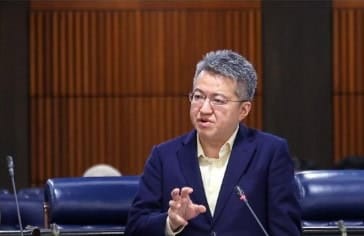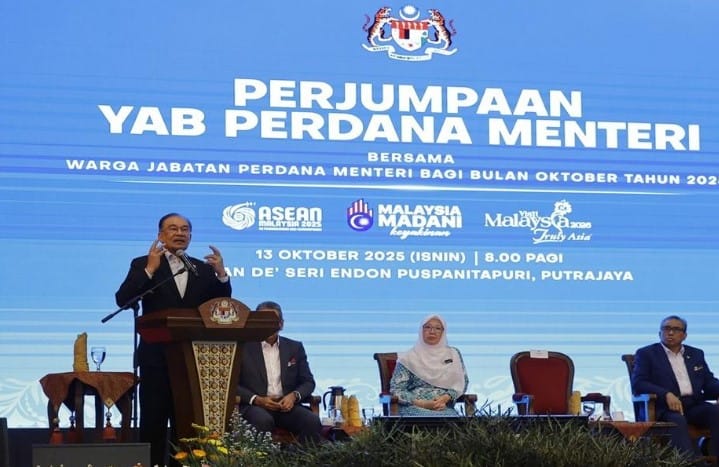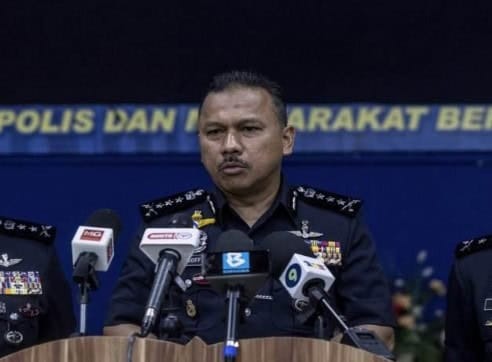
MONTREAL, Jan 3 – Key success insights from Sabah’s Living Landscapes Approach (LLA) to biodiversity conservation were featured at the United Nations’ 15th Conference of the Parties (COP15) here.
A mini documentary entitled ‘Bornean Elephants – A Journey Through Living Landscapes’ was unveiled to the audience on the sidelines of the Convention for Biological Diversity (CBD) on Dec 15.
About 100 visitors comprising delegates and observers of COP15 watched the 10-minute video produced by the World Wildlife Fund (WWF) Malaysia at Quebec Hall, Montreal Convention Centre.
An excerpt from the video footage showed an elephant ranger of the Sungai ethnic group from Kinabatangan, Sabah, known only as Jojo, sharing his experience in taming wild elephants.
Jojo who was once afraid of elephants, said taming an elephant requires courage, perseverance and an unwavering desire to have some measure of control over a wild beast.
He said Sungai Kinabatangan villagers were previously haunted by herds of wild elephants that had strayed into the village, destroying their houses and crops, with some folks killing them for their own safety.
Also highlighted in the documentary are conservation efforts undertaken by Pemuliharaan Biodiversiti Sabah or locally known as ‘Seratu Aatai’ (which means solidarity in the Sungai lingo), which was established in December 2018 with a mission to create a society that is willing and capable to take responsibility to protect and coexist with elephants.
Founded by an elephant expert and conservation biologist from Universiti Malaysia Sabah (UMS), Dr Nurzhafarina Othman, the project is primarily focused in the Kinabatangan region of northern Sabah, dedicated to conserving endangered elephants through scientific research, community engagement and education, and awareness programmes.
LIVING LANDSCAPES APPROACH
WWF-Malaysia Conservation Director, Dr Henry Chan said the documentary takes the perspective of Bornean elephants in Sabah, of which only 1,500 remain in the wild, as they traverse through the landscape.
“It also shows how these gentle giants can co-exist with humans amidst different challenges that both they and their human counterpart face, as well as the LLA as a model of innovative nature-based solutions to protect biodiversity in balance with economic development.”

“Through its three pillars – Protect, Produce and Restore – the documentary explores the dynamics between people and elephants, highlighting the challenges for both as they share the same space and ultimately showing that a co-existence is sustainable and beneficial in the long term.”
“In fact, viewers will have the opportunity to appreciate the unique biodiversity that Sabah is blessed with and gain an in-depth understanding of the conservation efforts to continue to safeguard its environment,” he told Bernama.
Chan said the LLA combines conservation and sustainable development by integrating the protection of forests, wildlife and rivers, with Roundtable on Sustainable Palm Oil (RSPO)-certified production of palm oil, and restoration of ecological corridors and riparian reserves.
(RSPO Certifications assure the member has committed to and complied with sustainability requirements, and can make a claim on their certification status and communicate this throughout the supply chain).
“Through the programme, WWF-Malaysia will work in three priority landscapes such as Tabin, Tawau and Lower Sugut.”
“Subsequent conservation efforts will also continue in Central Forest, Kalabakan and Ulu Padas-Nabawan landscapes,” he said.
He said WWF-Malaysia has adopted LLA as its conservation strategy that balances biodiversity conservation and sustainable development in Sabah.
“This is in line with the state’s goal to achieve full RSPO and Malaysian Sustainable Palm Oil (MSPO) certification of all its palm oil plantations by 2025, which was initiated by the Sabah State Forestry Department in 2015.”
“It is a conservation approach – that protects forests, wildlife and freshwater ecosystems, supports the sustainable production of palm oil through certification, and restoration of forests through the establishment of wildlife corridors,” he noted.
WILDLIFE CORRIDOR
Malaysia is the world’s second largest palm oil producer after Indonesia, with the two nations’ combined production contributing 85 per cent of the total.
However, its cultivation and production have caused deforestation, pollution, land degradation and human-wildlife conflict.
Deforestation in Malaysia has endangered the Borneo elephant, which depends on forest connectivity to survive, by isolating it from large foraging grounds.
Sabah, Malaysia’s biggest palm oil-producing state with a total planted area exceeding 1.35 million hectares, is taking the necessary measures to position itself as a global leader in sustainable palm oil production.
Chan said the Sabah state government as well as plantation and agricultural companies, are working with WWF-Malaysia to create ecological corridors to enable the animals to travel between forest patches since 2012.
“We also partner with the Sabah state government to enable unrestricted passage for the elephants.”
“For example in 2020, a wildlife corridor has been built through a Sabah government-supported palm oil plantation to connect the nearly 42-square-mile Silabukan Protection Forest Reserve and the roughly 475-square-mile Tabin Wildlife Reserve,” he added.
He said in 2012, WWF-Malaysia started engaging with Sabah Softwoods Berhad (SSB), a mixed industrial tree and palm oil plantation to reduce crop damage and encourage coexistence in the landscape by allowing elephants to access certain parts of their plantation.
“SSB which is located in Tawau started experiencing crop damage between 2004 and 2011 due to the human-elephant conflict, amounting to a total of RM3.5 million or averaging half a million ringgit annually.”
“This close engagement led to the establishment of a 1,067-hectare wildlife corridor in 2013, to facilitate elephant movement throughout the landscape.”
“Since it adopted elephant conservation efforts in 2012, the damage dropped substantially to RM5,000 in 2018,” he said.
He said plantations welcome the pachyderms when the palms are mature, but saplings – palm trees that are below seven years old – are a draw for hungry elephants that damage the crops.
“For the first eight years after saplings are planted, the plantation establishes a perimeter fence to protect them, inhibiting the elephants’ ability to travel between reserves.”
“Loss of habitat connectivity increases the risk of inbreeding and the potential for human-wildlife conflict as elephants seek out resources in limited, fragmented areas.”
“The corridor — a wide pathway flanked by electric fencing, will protect fragile crops while allowing elephants and other wildlife to move freely through or around plantation land from the forest reserves of Ulu Kalumpang in the south and Ulu Segama in the north,” he said.
He said the wildlife corridor spans 14 kilometres long with varying widths of 400 to 800 metres depending on the terrain of the area.
“SSB has invested RM1.76 million to replant the wildlife corridor with an assortment of native plant species and fruit trees that are important to fruit-eating forests animals.”
“In support of this restoration effort, Unilever, a global company has provided resources to co-fund plant tree species along other parts of the corridor,” he said.
COLLARING ELEPHANTS
He said in 2014, WWF-Malaysia started collaring a total of 24 elephants in Sabah and has since had a better understanding of their movement patterns on the plantation.
“We collaborate with Sabah Wildlife Department (SWD) and Sabah Department of Veterinary Services to put collars on the selected elephants which are linked with the Satellite to monitor their movement.”
“This crucial data is used to guide land use plans, and the placement of electric fences as well as, to assist the company to plan their operations around elephant movements for safety measures.”
“In fact, we also support planting native vegetation to restore riverside habitat to attract elephants and tree-dwelling species, such as Orang Utans and gibbons, to the area,” he said.
Thus, Chan said it is crucial for all plantation owners, especially those whose lands are located adjacent to forests, to set aside part of their land as wildlife corridors.
“We are willing to work together with any state government, plantation companies as well as local communities to make this happen.”
“To put it plainly, we have to accept that Bornean elephants will continue to travel through plantations.”
“We want to have the support of plantations to manage human-wildlife conflict responsibly,” he said.
SUSTAINABLE PLANTATIONS
In October 2022, Sabah Chief Minister Datuk Seri Panglima Hajiji Noor was quoted as saying, the state produced 4.36 million tonnes of palm oil in 2021 with 4.02 million tonnes exported to countries such as the United States, China, the European Union (EU) and South Korea.
He said its exports of palm oil and other palm-based products increased by 58,343 tonnes to 3.04 million tonnes for the period January to August 2022 from 2.98 million tonnes during the same period in 2021.
Naturally, Sabah has not been exempt from widespread criticism, what with the international media often alleging that the opening of oil palm plantations is causing massive deforestation and loss of wildlife habitats in the state.
How does the state strike a balance between conserving the environment and boosting its palm oil industry?
Sabah Forestry Department chief conservator of forests, Datuk Frederick Kugan told Bernama, the state has embarked on a policy initiative to protect the resilience of the palm oil sector as the foundation of the economy and sustainable development.
“This is through the implementation of both the Jurisdictional Certification of Sustainable Palm Oil (JCSPO) and the Malaysian Sustainable Palm Oil (MSPO) certification concurrently within Sabah, which involves some 1.7 million ha of oil palm including smallholders.”
“The JCSPO is very important to ensure conservation and sustainable development, and certification of palm oil production is necessary, especially in addressing issues such as chemical use and labour standards,” he said.
A 10-year initiative since 2015, the JCSPO aims to transform the state’s palm oil production and supply chain, halt deforestation, restore the ecosystem and secure sustainable livelihoods which include assisting smallholders to achieve RSPO certification by 2025, in addition to the MSPO certification, said Kugan.
“This is to achieve no loss of High Conservation Value (HCV) and High Carbon Stock (HCS) forests for all oil palm in Sabah, enable zero-conflict in oil palm production landscapes in Sabah, and strengthen smallholder sustainability and uplift local livelihoods by 2025.”
“The rationale for embarking on the jurisdictional approach is to ensure Sabah’s palm oil, especially the smallholders, remains relevant and competitive in the market through cost-effective group certification at the state level albeit small but compete in terms of good governance,” he said.
Kugan said the Bornean elephants often face problems from the palm oil plantations where human–elephant conflict incident exists.
He said the holistic approach offered by JCSPO provides the platform for plantation companies and local communities to find solutions together and therefore allows the gentle giants to co-exist with humans and development.
“A larger perspective is needed to safeguard wildlife populations, forest resources and ecosystems. Thus, finding a common ground is vital so that nature, as well as the palm oil industry, benefit from each other.”
“I think we have done much to achieve great conservation efforts in Sabah that can, in fact, benefit other sectors, especially palm oil,” he added.
30 PER CENT PROTECTIVE AREAS
Kugan said to date, about 64 per cent or 4.7 million ha are still forested and out of these, 3.8 million ha, or 52 per cent of the state land mass have been legally gazetted as permanent forest reserves, parks and wildlife conservation areas.
“In addition, Sabah had also further pledged since 2013 and later incorporated into the state forest policy 2018 to increase forests under Totally Protected Areas (TPAs) to 2.2 million ha or 30 per cent of the state’s landmass by 2025.”
“Even the newly adopted Kunming-Montreal Global Biodiversity Framework (GBF) had set the 30 by 30 goals, which protect at least 30 per cent of the land and ocean by 2030, we already implemented it since 2013,” he said.
He said through the implementation of the Heart of Borneo Initiative, various efforts to improve biodiversity conservation have been undertaken.
“This includes among others, conducting research expeditions to identify critical HCV areas for the expansion and consolidation of TPAs, intensification of forest rehabilitation activities in areas which are devoid of forests, strengthening the implementation of Sustainable Forest Management (SFM) and exploring the potential of forest-based ecotourism,” he said.
He said about 1.9 million ha or 26 per cent of the state’s landmass had been designated as TPAs to date with a remaining of about 300,000 ha yet to be identified within the next three years until 2025.
“An achievement that the state is proud of as it has not only exceeded the National commitment on having 50 per cent under forest cover but also targets set by The International Union for Conservation of Nature (IUCN) to conserve around 17 per cent of terrestrial and inland water areas plus a further 10 per cent of coastal and marine areas,” he said.
The Kunming-Montreal Global Biodiversity Framework (GBF), which was adopted during the COP15 on Dec 19, contains visionary goals for 2050 and 23 targets for 2030 to preserve and restore nature, protect biodiversity and prevent the extinction of species.
The 30×30 goal, which is the GBF’s centrepiece, commits countries to effectively conserve at least 30 per cent of the world’s lands, inland waters, coastal areas, and oceans, and to restore 30 per cent of already degraded terrestrial and marine environments.





More Stories
Nation Recovers RM15.5 Billion Of Its Revenue, War Against Corruption And Cartels To Go On – Anwar
Budget 2026 Reflects Govt’s Commitment To Integrity, Curbing Leakages – Azam
Dewan Negara Passes Five Bills Including Legal Aid And Public Defence 2025